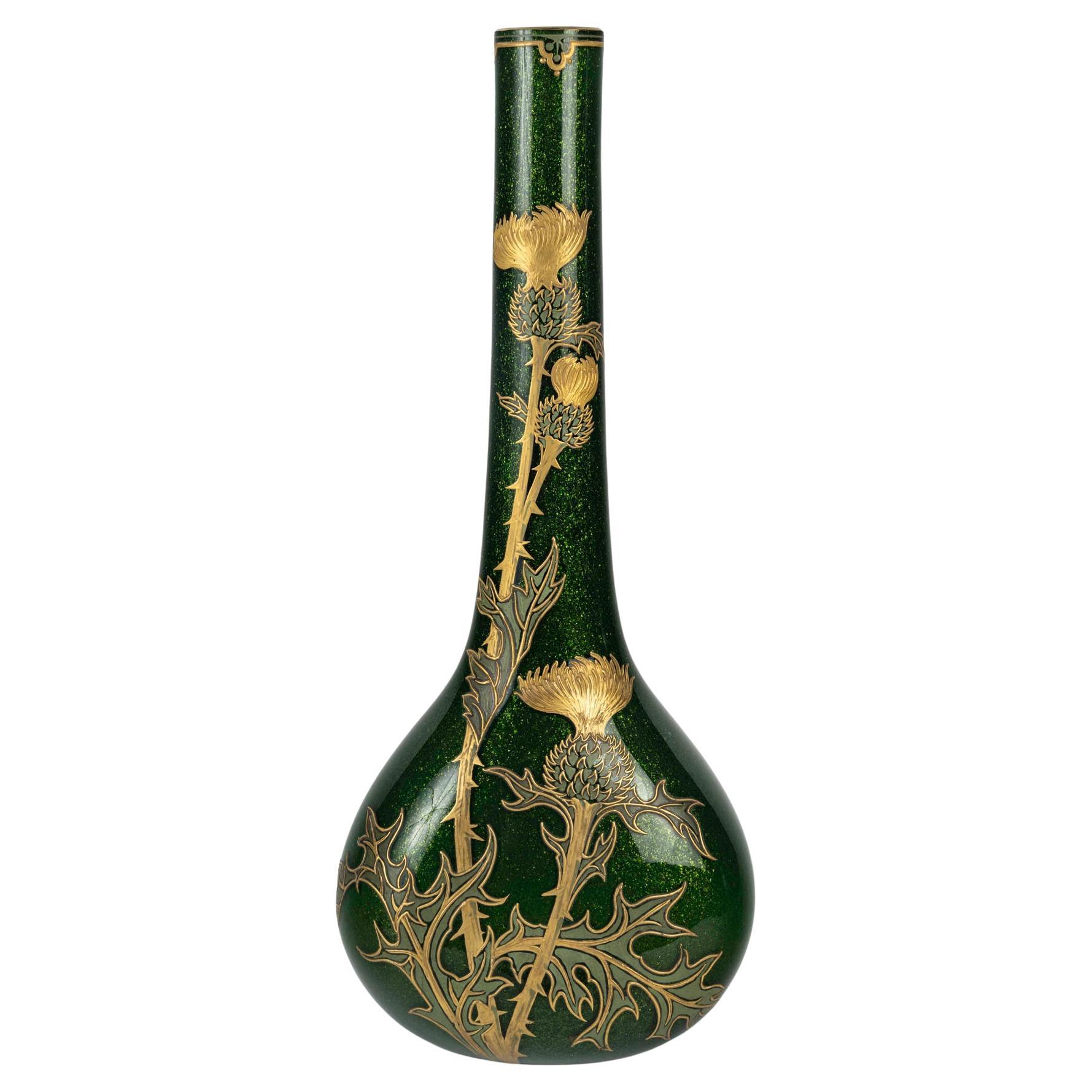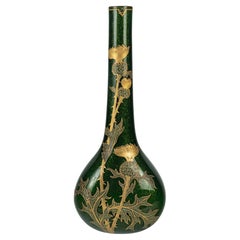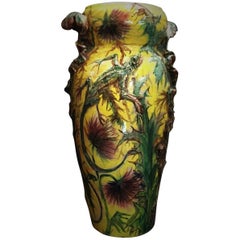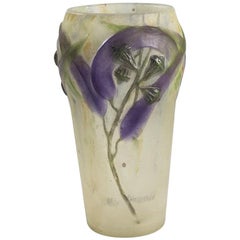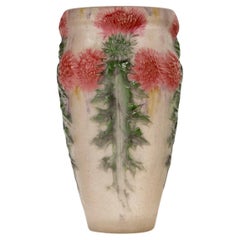Want more images or videos?
Request additional images or videos from the seller
1 of 11
Gabriel Argy-Rousseau"Thistles" vasecirca 1915
circa 1915
$11,279.90
£8,609.96
€9,600
CA$15,907.64
A$17,477.38
CHF 9,133.78
MX$208,432.20
NOK 115,658.43
SEK 107,745.58
DKK 73,170.44
About the Item
" Thistles" vase
by Gabriel ARGY-ROUSSEAU (1885-1953)
Small glass paste vase,
in green, purple and orange on a white background,
decorated with thistles.
Signed " G. Argy-Rousseau "
numbered underneath " 8671 "
Perfect condition
France
circa 1915
height 10 cm
diameter 10 cm
Model presented in 1915, reproduced in "Les pâtes de verre, catalogue raisonné G. Argy-Rousseau", Les éditions de l'amateur, p.178.
Biography :
Joseph Gabriel Rousseau called Gabriel Argy-Rousseau (1885-1953) was a French sculptor, ceramist and glassmaker who contributed to the rediscovery of cameo glass as a major glass art of the early twentieth century. If the technique of cameo glass dates back to ancient times, it fell into oblivion for a long time. In the last quarter of the nineteenth century, Henri Cros and a handful of artists, often ceramists of the Art Nouveau movement, such as François Décorchemont or Georges Despret, put it in the spotlight. The last of these precursors was Gabriel Argy-Rousseau. He was considered as the only glassmaker to have developed and used the complex process of cameo glass, the other glassmakers working with crystal paste.
Entering the Ceramics School of Sèvres, he discovered the cameo glass in the workshop of Henri Cros. Gabriel Argy-Rousseau began to produce between 1910 and 1920. His early works were influenced by Art Nouveau style plant motifs and animal themes. He began at the 1914 Salon of the French Artists in Paris. Between 1921 and 1931, established rue Simplon in Paris, he was a shareholder in the Argy-Rousseau cameo Glass Society. With many collaborators, he produced small very colorful Art Nouveau and Art Deco subjects, distributed in small series: pendants, vases, lamps and night lights and, from 1928, sculptures (statuettes or bas-reliefs) in collaboration with Marcel Bouraine. Unlike his fellow ceramicists, he remained belatedly faithful to the polychrome effects and floral motifs of Art Nouveau style. He developed shimmering colors (ruby red, amethyst, gray, deep blue ...) and textures with marbled effects. He invented new processes for the superficial coloring of the paste, by painting oxide powder before second firing at a low temperature. His works were in glass paste, the statuettes usually in crystal paste.
The glass creations of Gabriel Argy-Rousseau remain among the most typical and representative examples of Art Deco production. The production of the workshop ceased in 1931, but Argy-Rousseau continued to create pieces of crystal paste, because of the economic crisis, the opportunity to work the expensive process of the glass paste was no longer possible. He exhibited punctually, especially in 1934, glassware adorned with precious metals. His last exhibition took place a year before his death in 1952. He died forgotten, but left many works in the glass branch, now rediscovered.
- Creator:Gabriel Argy-Rousseau (1885 - 1953, French)
- Creation Year:circa 1915
- Dimensions:Height: 3.94 in (10 cm)Diameter: 3.94 in (10 cm)
- Medium:
- Movement & Style:
- Period:
- Condition:
- Gallery Location:PARIS, FR
- Reference Number:Seller: N.X1stDibs: LU2514216651822
Joseph Gabriel Rousseau called Gabriel Argy-Rousseau (1885-1953) was a French sculptor, ceramist and glassmaker who contributed to the rediscovery of cameo glass as a major glass art of the early twentieth century. If the technique of cameo glass dates back to ancient times, it fell into oblivion for a long time. In the last quarter of the nineteenth century, Henri Cros and a handful of artists, often ceramists of the Art Nouveau movement, such as François Décorchemont or Georges Despret, put it in the spotlight. The last of these precursors was Gabriel Argy-Rousseau. He was considered as the only glassmaker to have developed and used the complex process of cameo glass, the other glassmakers working with crystal paste. Entering the Ceramics School of Sèvres, he discovered the cameo glass in the workshop of Henri Cros. Gabriel Argy-Rousseau began to produce between 1910 and 1920. His early works were influenced by Art Nouveau style plant motifs and animal themes. He began at the 1914 Salon of the French Artists in Paris. Between 1921 and 1931, established rue Simplon in Paris, he was a shareholder in the Argy-Rousseau cameo Glass Society. With many collaborators, he produced small very colorful Art Nouveau and Art Deco subjects, distributed in small series: pendants, vases, lamps and night lights and, from 1928, sculptures (statuettes or bas-reliefs) in collaboration with Marcel Bouraine. Unlike his fellow ceramicists, he remained belatedly faithful to the polychrome effects and floral motifs of Art Nouveau style. He developed shimmering colors (ruby red, amethyst, gray, deep blue ...) and textures with marbled effects. He invented new processes for the superficial coloring of the paste, by painting oxide powder before second firing at a low temperature. His works were in glass paste, the statuettes usually in crystal paste. The glass creations of Gabriel Argy-Rousseau remain among the most typical and representative examples of Art Deco production. The production of the workshop ceased in 1931, but Argy-Rousseau continued to create pieces of crystal paste, because of the economic crisis, the opportunity to work the expensive process of the glass paste was no longer possible. He exhibited punctually, especially in 1934, glassware adorned with precious metals. His last exhibition took place a year before his death in 1952. He died forgotten, but left many works in the glass branch, now rediscovered.
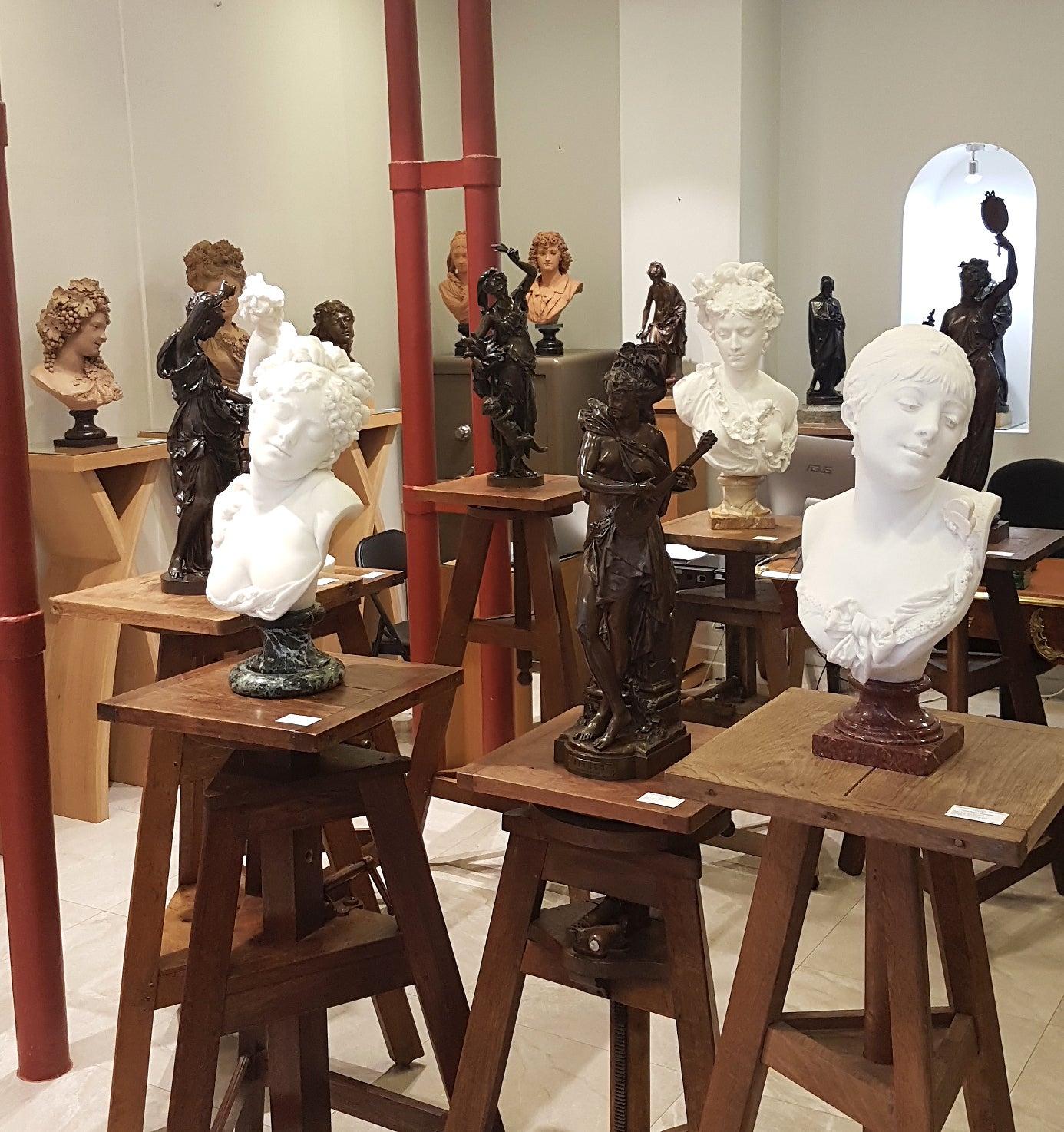
About the Seller
5.0
Recognized Seller
These prestigious sellers are industry leaders and represent the highest echelon for item quality and design.
Established in 1992
1stDibs seller since 2023
11 sales on 1stDibs
Typical response time: 12 hours
- ShippingRetrieving quote...Shipping from: PARIS, France
- Return Policy
More From This Seller
View All"Bellflowers" Vase
By Émile Gallé
Located in PARIS, FR
"Bellflowers" Vase
by Émile GALLE (1846-1904)
A very rare shell-shaped vase,
double-layered blown glass with powder and silver foil inclusions.
Wheel-carved cameo decoration ornate...
Category
Early 20th Century Art Nouveau More Art
Materials
Blown Glass
Vase with Dandelions
By Daum
Located in PARIS, FR
Vase with Dandelions
by DAUM
Vase decorated with Dandelions
Blown-molded triple layer glass
Acid-etched decoration in reserve and wheel cut
Hammered background
Signed underneath "D...
Category
Late 19th Century Art Nouveau More Art
Materials
Blown Glass
Important vase with Clematis
By Émile Gallé
Located in PARIS, FR
Important vase with Clematis
by Etablissements GALLE
A very important baluster shaped vase with a flared neck
Multilayer glass
decorated with acid-etched blue and brown Clematis
on...
Category
Early 20th Century Art Nouveau More Art
Materials
Glass
Vase with Clematis
By Émile Gallé
Located in PARIS, FR
Vase with Clematis
by Émile GALLE (1846-1904)
A baluster-shaped vase ornated with clematis.
Green, purple and opalescent multi-layered glass.
The fine floral decoration was made bo...
Category
Early 20th Century Art Nouveau More Art
Materials
Blown Glass
Small vase with Clematis
By Daum
Located in PARIS, FR
Small vase with Clematis
by DAUM
A small quadrangular vase with a narrow neck and raised on foot
decorated with purple Clematis
Blown-molded double layer glass
Acid-etched decoratio...
Category
Late 19th Century Art Nouveau More Art
Materials
Blown Glass
Vase with Asters
By Daum
Located in PARIS, FR
Vase with Asters
by DAUM
A cornet-shaped vase on foot,
Multi-layer blown-molded glass,
with blue Asters decoration.
With acid-etched decor in reserve, and wheel-carved flowers.
With...
Category
Early 20th Century Art Nouveau More Art
Materials
Blown Glass
You May Also Like
Montjoye Vase, Thistle Design, Iridescent Glass, 1900, Art Nouveau.
By Verreries Montjoie
Located in Saint-Ouen, FR
Montjoye vase, thistle design, iridescent glass, 1900, Art Nouveau.
Vase with thistle decoration, Vase Montjoye, iridescent glass, 1900, Art Nouveau period.
H: 45.5cm, W: 19cm, D: 12cm
Category
Early 20th Century French Art Nouveau Vases
Materials
Glass
French Art Nouveau Majolica Vase with Thistles and Lizards, circa 1900
Located in New York, NY
This beautifully designed and highly decorative Art Nouveau ceramic vase is outstanding by all measures. It is very impressive and fabulously rendered in a most unusual technique, co...
Category
Antique Early 1900s French Art Nouveau Vases
Materials
Majolica
French Art Nouveau Vase, "Eucalyptus, " by Gabriel Argy-Rousseau
By Gabriel Argy-Rousseau
Located in New York, NY
A French Art Nouveau pâte de verre vase, "Eucalyptus," by Gabriel Argy-Rousseau. The vase has three isolated brown branches, each with curving purple and green leaves, and flower bud...
Category
Vintage 1910s French Art Nouveau Vases
1920 Gabriel Argy Rousseau Vase Red Thistles Chardons Rouges Glass Pate De Verre
By Gabriel Argy-Rousseau
Located in Boulogne Billancourt, FR
Vase "Chardons Rouges" (Red Thistles) made in white, green and red glass pate de verre by Gabriel Argy-Rousseau in 1920.
Molded signature and numbering.
Perfect condition. Very beau...
Category
Vintage 1920s French Art Deco Vases
Materials
Blown Glass
Edith D Lupton Doulton Lambeth Aesthetic Movement Thistle Vase
By Edith Lupton
Located in Bishop's Stortford, Hertfordshire
An unusual and stunning aesthetic movement Doulton Lambeth Silicon Ware vase decorated with incised and pate-sur-pate thistle designs by r...
Category
Antique 1880s English Aesthetic Movement Vases
Materials
Stoneware
Vase with Thistles Signed Verlys
By Verlys Glass
Located in Beaune, FR
Blue opalescent molded and pressed glass vase decorated with thistles signed Verlys France under the feet of the vase. It is in very good condition .
Dimensions
Height: 25 cm
Neck d...
Category
20th Century French Art Nouveau Glass
Materials
Art Glass
